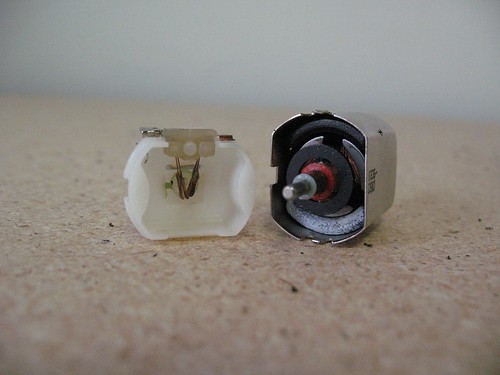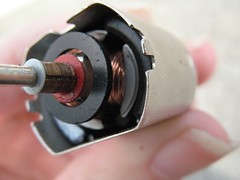Take Apart Tuesday No. 5: Electric Toothbrushes
This week’s Take Apart Tuesday is going to be a little light because we really spent the time after the meeting watching LOST. LOVED IT.
I had dismantled two electric toothbrushes over the weekend preparing for an Introduction To Electronics class I’m teaching at Machine Project in March. I pretty much threw the parts on the table like chum saying “keep the talking to the commercials people.”
That said I have written up a little bit about the nature of DC motors and provided links.
DC motors are pretty much a piece of cake compared to stepper motors. No multiple leads attached to separate coils, no microcontrollers necessary. In fact the most basic circuit is just a motor, a power source and maybe a switch. This motor is a very low-current, low-voltage motor that isn’t going to face a lot of resistance as it runs. In higher voltage/current situations you’ll likely see diodes and capacitors thrown into the mix to improve performance and stability. You might also see ways to change the motor’s speed or direction. I’ll talk about that stuff during the class.
Just like steppers, however, DC motors move because of the joys of electromagnetism. Perhaps the best way to really get a handle on that is to build you own motor from scratch by either follow directions like the ones on the Exploratorium site and using materials you scavenge up yourself or by buying a kit. It can make a big difference to see the effect in action.
Commercial toy motors are commonly configured with 2 stationary magnets of opposite orientations (field magnets) jammed up against an the outside of the housing (stator). In the center is an electromagnet created by running current through coils wound about an armature (sometimes called a rotor). This armature is attached to the axle. The current comes to the electromagnet through contacts on the axle which are rubbing against two brushes on the casing. In the toothbrush circuit each brush is attached to a different end of the battery.
The commutator (fancy name for axle contacts) allows the axle to spin freely unfettered by wires that would twist and snap while still allowing power to flow to the electromagnet. Because of the way the separate contacts on the axle are configured, the axle spinning translates into a change in the direction of the current through the coil windings of the electromagnet. The change in the direction of the current means the poles of the electromagnet invert. That flip happens at just the right time to prevent the magnets from getting comfortable with each other and reaching a stasis. The constant change keeps the motor agitated and in motion.
A lot of the “build your own motor” examples and basic “how motors work” illustrations show an armature shaped like a bar with only two coils. While that keeps things simple when explaining the concept, once you crack open a real motor there are going to be at least three windings. Having three makes for much smoother motion and the Solarbotics site has a nice animation of how that works.
This motor is pretty straight forward and will run off a 1.5 AA battery. But what if I gave it more juice? Different motors will have different strength magnets, have their wires wrapped around the armature more or less times, simply be bigger or smaller, etc. Therefore, each motor has different current and voltage requirements, and limitations. I found one article that talked about what to do if you get a motor and don’t know how much power it needs. It presumes quite a bit of knowledge and a way to detect RPM, but is super handy if you buy surplus motors. It is even handy if you pull a motor out a known circuit as the manufacturer might be starving or pushing the motor too hard.
The next time we have a surplus DC motor with no basic information to be found I’ll break down/illustrate his instructions the best I can. The more low-tech way to do things is to simply apply a low courrent/voltage source to the motor and slowly increase power to it until there is movement.
Happy motoring!




Pingback: Crash Space » Blog Archive » Take Apart Tuesday No. 6 – HP 1120C